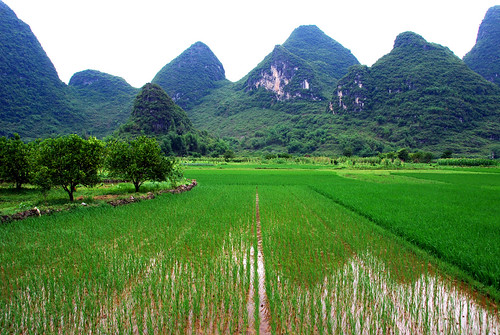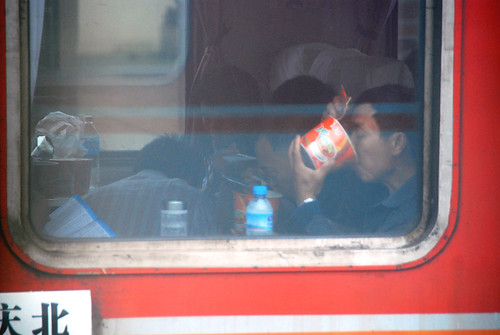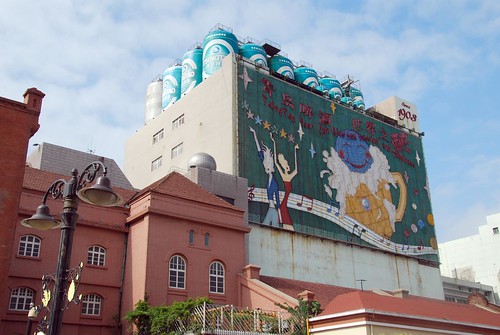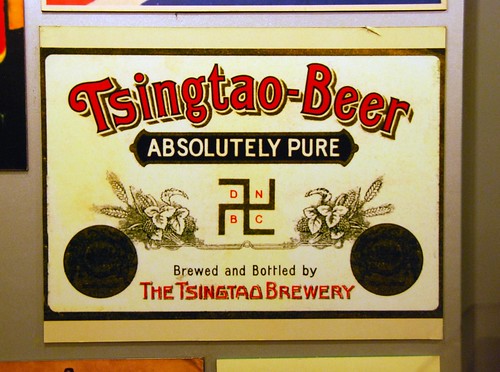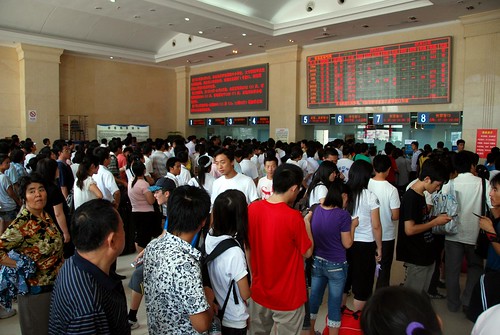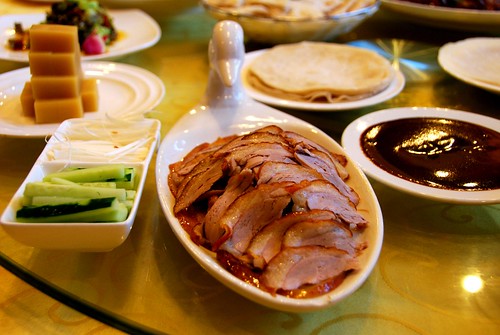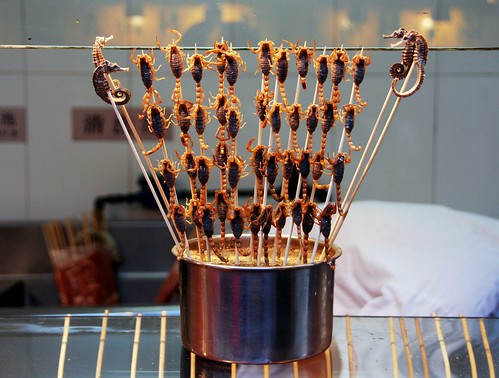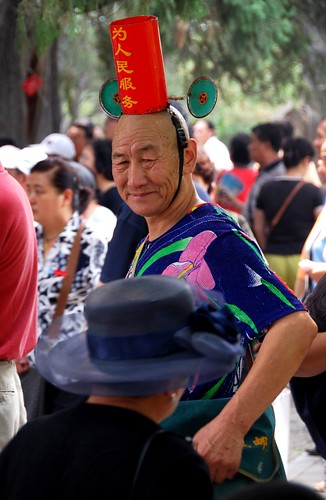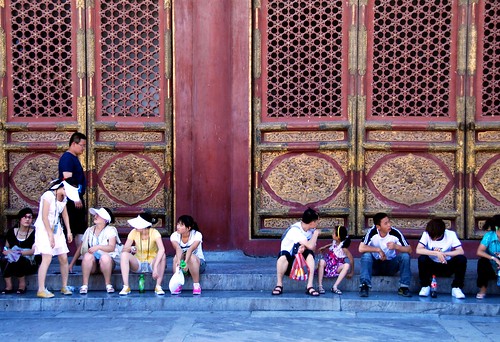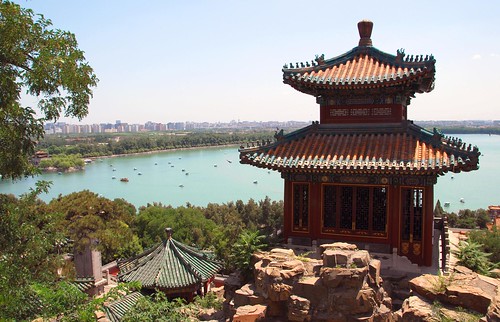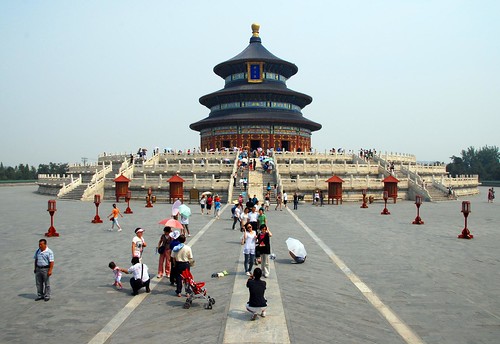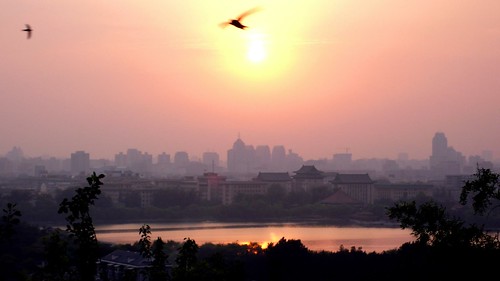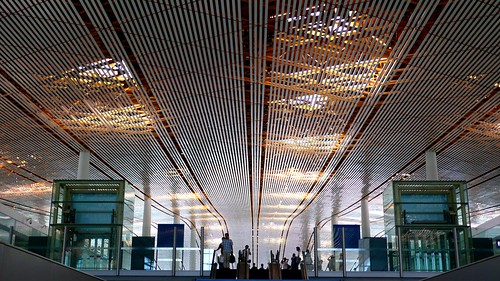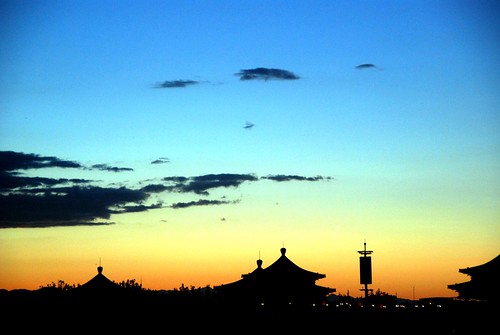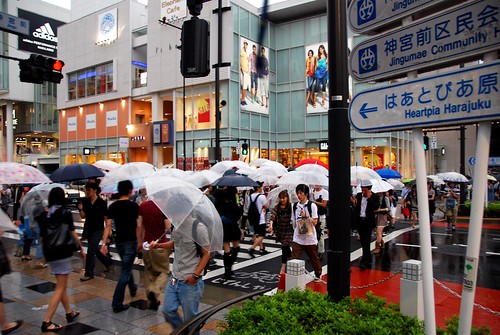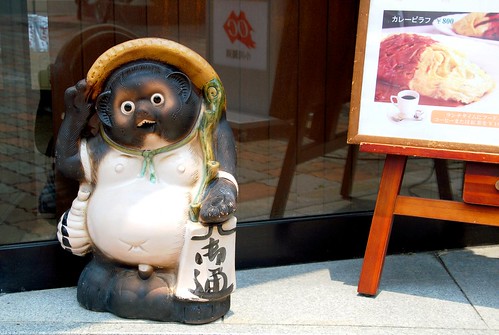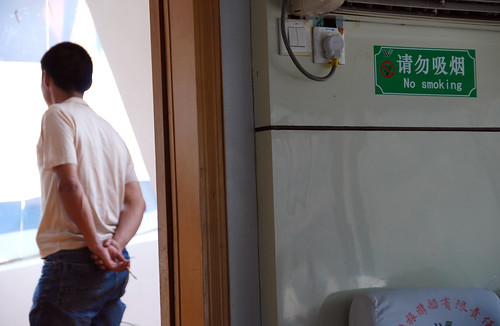Search results for "beijing"
I didn’t want to go to London.

Can this photo scream “London” any louder?
It’s not that I wasn’t interested—I’ve never been there (Jeremy has) and I was curious about the place, but just not now. I didn’t feel like it was very exotic—the UK is a place we could travel with kids later on in life, and I was gung ho to continue roughing it.
Two months in China changed my mind.
More accurately, two months of intense heat in China changed my mind. Originally, our around-the-world tickets had us flying from Beijing to Amman, Jordan. Call that poor research on our part—flying to the middle of the desert in July? Not smart. We needed to kill some time while the planet cooled down a bit before heading to the Middle East, and we had a friend offer us her place in London (which is the only way it would have been affordable for us to visit). So why not? We chose Qingdao based on the climate, why not London?
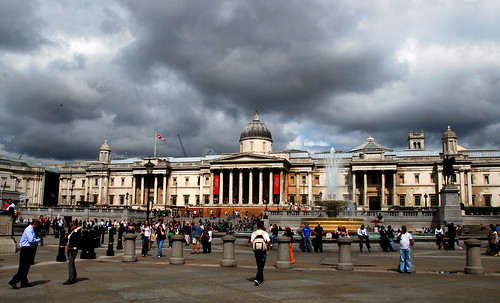
Ominous-looking clouds over the National Gallery. If you ever feel like complaining about the miserable weather in the UK, just spend two months in the oppressive heat of China. Then London will feel like heaven on earth. A nice, cool, sometimes rainy heaven on earth.
Plus, China was tough, and we were kind of over it by the end (it’s worth noting, however, that the misery has diminished with time—we think of China fondly now). As London loomed closer in our calendars, I started positively salivating at the thought of indulging in Western “comforts” like throwing toilet paper in the toilet and drinking tap water. And, I felt there was a kinship between Americans and Brits. I imagined landing at the airport and feeling like I was in a home away from home. They’ll welcome us with open arms and we’ll all make jokes in English and maybe they’ll offer us a spot of tea and crumpet. Right?
Not so much.
Of all the immigration checkpoints we’ve been through, I’ve never been grilled as hard as I was entering London. Why was I here? (Tourism.) Where am I staying? (With a friend.) How long am I planning on staying? (Three weeks.) What was I planning on doing? (I don’t know yet.) You are going to be here for 3 weeks and you don’t know yet? (Um, I guess I’ll go see Buckingham Palace?) After about 5 minutes of rapid questioning, the immigration officer was finally satisfied and let me through. I found out later that they go through this whole rigamarole to see if there are any inconsistencies in your story. You know, just in case your occupation starts with the letter “T.” And rhymes with “herrorist.”
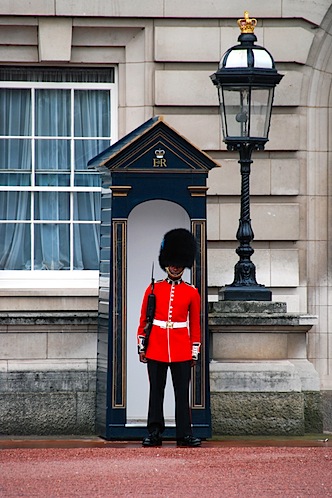
Um, excuse me, but I think your hat is a little crooked.
I quickly found out that Jeremy too got yelled at by the immigration officer for not going up to the window with me (I guess families are supposed to go through together). And then some lady bumped into me and said “Watch where you’re going.” Suddenly the chaos of China isn’t looking so bad…
Despite the shaky start, we ended up having a great time in London. It didn’t hurt that we have a lot of friends here (and made new ones). Our friend Chi-Chi generously let us crash in her guest room for a whopping 10 days, so we felt right at home. Minus the passive aggression.
Oh, the highs and lows of traveling through China! There were definitely some lows (see Qingdao: Confronting Identity in a German Town in China and Yangshuo: Anatomy of a Scam), but the peaks and the valleys seem to flow into one another so that you’re no longer sure what hurts so bad and what hurts so good. Our Yangzi Three Gorges River Cruise is the perfect metaphor: we spent three days on a 4th class river boat with a bunch of half-naked Chinese people who only stopped smoking cigarettes, spitting, and playing mahjong long enough to follow a megaphone-wielding tour guide around in 100 degree heat. Yes, it was unpleasant at the time. But even now, almost 3 months after the fact, we bring it up in conversation almost every week and giggle at the absurdity of it all. It’s sort of like running a marathon: when you’re in the moment, you can feel blinded by the pain, but once it’s over, you’re really glad you did it.
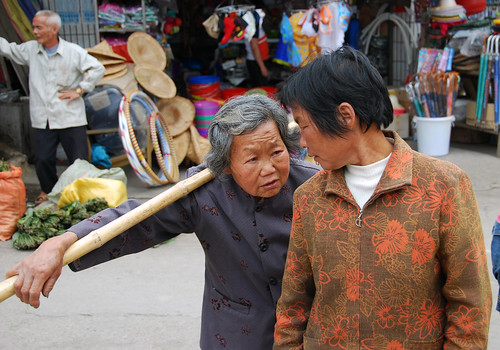
Ladies at the market near Hakka House.
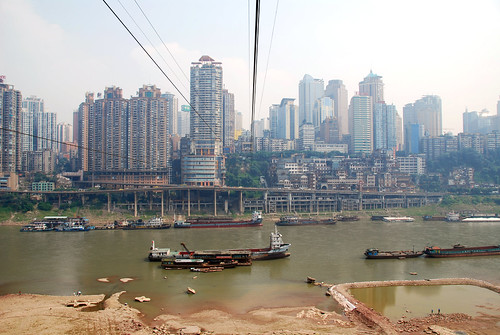
View of Jiefangbei from across the Jialing River in Chongqing.
As Jeremy put it, “of all the countries we’ve been so far, China is the one I would have most regretted missing.” China is relevant, y’all. It is freaking fascinating there right now, a place where nothing stays the same for more than a few weeks, the government is still messing with people’s civil liberties in exchange for making them rich, and people are spitting on the street in their US$500 Gucci heels. We think every Westerner should go. Observe. Learn. And see what a country of 1.3 billion people all working together to pull their country up by its bootstraps looks like. There’s no place like it.
Days spent here: 43 (26 days in Southern and Central China, 17 days in the North)
Highlights: Huangshan, Yangshuo (for Jeremy), Yangzi River Three Gorges Cruise (somewhat painful, but also unforgettable), Beijing
Places we would like to visit next time: Western China (i.e., Tibet, Xinjiang, Jiuzaigou) and Mongolia
Average daily expenditures (for two people): US$213 for 13 days on our 5 star hotel/fancy eating tour with my parents (heavily supplemented by Jack and Wendy—thanks Mom and Dad!), US$120 for the remaining 30 days on our usual 1 star hotel/street food backpackers tour
Prices: China’s pretty reasonable. Food is very inexpensive (from US$5-10 per person per meal) and accommodation can be pretty cheap too. On average, we paid about 200 RMB (approx. US$30) per night for a double room ensuite. We used hostelbookers.com and Ctrip.com to book our accommodation, and we got great deals using both websites.
Weather: Do yourself a favor and don’t visit northern China in June or July, unless you like your searing heat with a dash of crushing humidity. Don’t say we didn’t warn you.
Language: There are 300 million people in China learning English right now—that’s the same number of people that live in the US! But you wouldn’t know it from traveling in this country. If you don’t speak Mandarin, polish your pantomiming skills before you go. On the other hand, if you are a wai guo ren with Mandarin speaking skills, prepare to be worshipped. The people will fall all over themselves with delight.
If you do speak Chinese, be warned that you will need to overcome not only regional accents, but regional phrases as well (ex. if you are from Taiwan, you will call a spoon a tiao gen, but a Beijinger will refer to it as a shao zi). For instance, I had the following conversation with a person in Taishan (in Chinese, of course):
Hope: Excuse me, do you know if there is a pharmacy around here?
Random Person: A what?!? A pharmacy?
H: Yes, a pharmacy.
RP: I don’t know. Why don’t you go ask over there [points to a pharmacy], at the medicine store?
Oh yeah, and if you’ve ever been interested in visiting China, go now, before all the Chinglish gets wiped out.
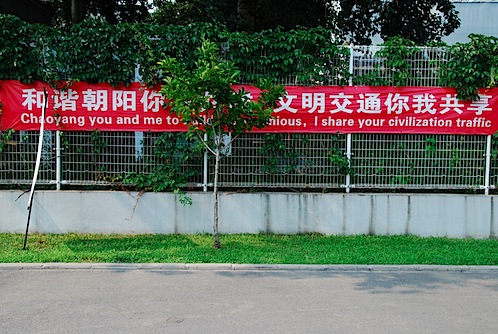
One day, China will be void of gems like this (reads: Chaoyang you and me to build harmonious, I share your civilization traffic)
Food: Outside of our eating tour with my parents and the food in Beijing, we weren’t too impressed with Chinese cuisine. We said it before and we’ll say it again: if you want the best Chinese food in the world, go to Taiwan.
That being said, China is a great place if your culinary hero is Anthony Bourdain. We got over ourselves really fast in Chongqing, where my aunt’s friends took us out to meals involving pig brains, duck tongues, cow rumen, and various other intestinal elements. You can also try snake, turtle, or live scorpions. Yum?
Transit: China’s got a pretty good rail system for such a big country. Chinese trains are not quite as nice as the trains in Taiwan or Japan, but they’re not as bad as the trains in Vietnam, either. For long journeys, you can purchase tickets for a soft sleeper (most expensive), hard sleeper, soft seat, or hard seat (cheapest). Soft sleeper trains are pretty nice, with 4 beds in each room, AC, clean sheets, and relatively clean bathrooms. “Hard sleeper” sounds scary, but it’s worth noting that hard sleeper beds aren’t hard—the mattress is just a little bit thinner. The biggest difference is that there are 6 beds in the hard sleeper rooms rather than 4. Since J and I are tall, we usually traveled in the soft sleeper trains, which are still relatively cheap, even though tickets are 1.5-2 times as much as the hard sleeper carriages.
For information on routes, schedules, and prices, check out ChinaTravelGuide.com’s fabulous online train schedule database.
The bigger cities like Shanghai and Beijing have subways, but Shanghai’s subway system has pretty bad signage and confusing connections. Beijing’s subway did not reach most of the sites in the city center, so we did a LOT of walking or took taxis. Luckily, taxis are very cheap in China’s capital city, but you’re going to have to speak Mandarin in order to get where you want to go.
Internet: Web access is great all over China—as long as the government isn’t blocking the site you want to surf. YouTube, Flickr, Facebook, Twitter, and all blogspot sites got blocked for periods of 3-10 days while we were in China due to the 20th anniversary of Tiananmen Square and the deadly Uighur protests in Xinjiang. Annoying.
Culture: Get ready for a culture shock. Get ready for people constantly cutting in front of you in line. Get ready for men walking around in inappropriate places with their shirts hiked up above their nipples. Get ready for spitting. Get ready for half-naked babies pooping in the street. Get ready for smoking. Get ready for LOUD. That being said, once you figure out how things work, it’s easy enough to deal with them.
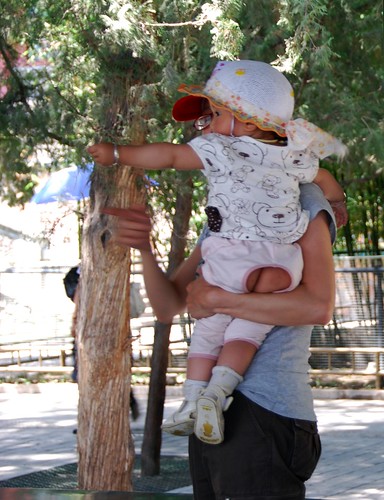
Baby at the Summer Palace wearing the poop pants.
One fascinating thing about traveling through Taiwan and China is that we got a firsthand look at how differently these two countries developed culturally. The Taiwanese are exceedingly polite, aggressively helpful, and overly concerned about safety. The Chinese on the other hand, are rude and pushy, frequently uninterested in helping you, and some of the craziest drivers in the world. Now, you could point to many reasons for this cultural gap: the fact that it was the intellectuals and people of the upper classes that moved to Taiwan in 1949 to escape Communist persecution, the effect of 60 years of Communist rule on the people of China, etc. But I’d like to propose a different hypothesis: It’s the sheer numbers. There are 57 times as many people in China as Taiwan. You would get CRUSHED in China if you were nice and helpful to people all the time. The result is, if someone vouches for you in China (as my aunt did, in our case), you get extreme, excessive kindness from people that you may only marginally know you. But those same people on the street may wave you off if you ask for help. Yes, it’s a contradiction. But it’s a fact of life here. All I can say is, try to make friends with a local. If you do, you will get the red carpet rolled out for you.
In short: It’s not always pleasant, but that doesn’t mean it’s not a great time.
Since Tibet was out as our next destination, where to next? Mongolia? Train tickets were sold out for the entire week. Xinjiang? Tickets also sold out (and thank goodness we didn’t go because the deadly protests in Urumqi broke out a few days later). Here’s how we decided on our next stop: we consulted Weather Underground and looked for the coolest temps in Eastern China. Qingdao it is! Hey, we went to Malaysia for a good bowl of curry, why NOT choose a place based on the climate, especially after the heat in Beijing and Xian made us cry “uncle.”
Qingdao is a former German settlement in Eastern China known for its beach and its beer (which you may know by its Wade-Giles spelling, Tsingtao). It rained pretty heavily while we were there, but honestly, we didn’t care. As long as the the mercury didn’t climb above 90°, we were happy campers.
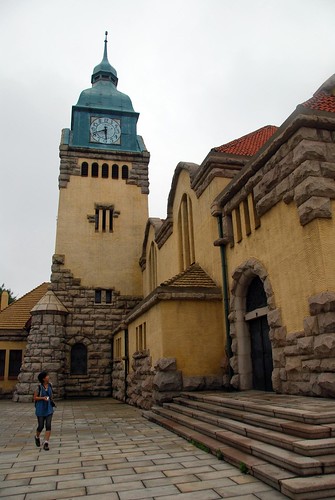
The Protestant Church in Qingdao.
Both German architecture and Chinese people on the beach are novel sights in China, which makes Qingdao a rare place indeed. But the brewery! Totally worth it, even though they were stingy with the free samples (a mere half pint!). The majority of the self-guided tour is pretty standard fare: the history of Tsingtao, different advertising campaigns, bla bla. What made the tour interesting is the actual, functioning bottling plant. I swear Jeremy and I stayed there for half an hour watching them bottle and can the Tsingtao brew. We’re nerds like that.
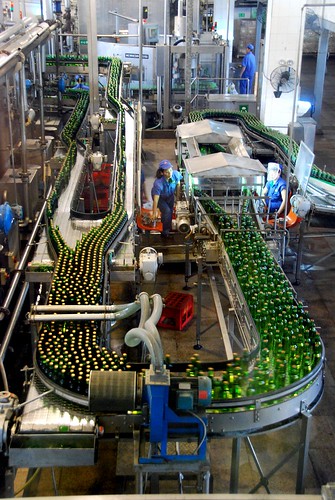
The Tsingtao bottling plant in action.
The other highlight of the Tsingtao brewery tour was the Drunk Room. Basically, it was a room where the floor was slanted. Simple but surprisingly effective! We totally felt drunk (it was BEFORE the tasting room, I swear)!
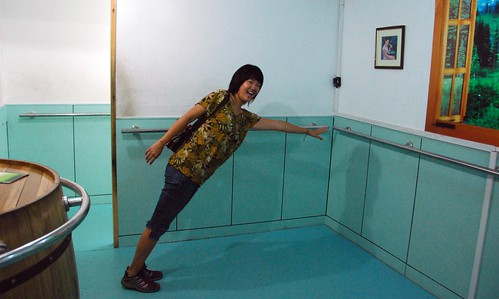
Me in the Drunk Room at the Tsingtao brewery.
I can’t say we loved our time in Qingdao…the city itself is really spread out, and beyond the brewery there isn’t much to do besides wander around the parks (which, I have to admit, are pretty nice), or try to find some German food to eat (surprisingly difficult in Qingdao! We only know of one place: Monnemer Eck, which is was dead empty when we dined there. Good food though!).
But there is one reason why this Chinese city will always stick out in my mind: I had a total meltdown trying to leave Qingdao. Are you ready for this?
We decided on our next destination (Taishan), and learned that there was both a bus and a train that could get us there. The express train left at 6AM, but only took 3 hours. The bus took 6 hours, left several times a day, and was cheaper than the train ticket. So J and I decided on the bus. Only thing is, NOBODY seemed to have any idea what time the bus left. There was no telephone number you could call, no schedule, and the bus station was about 15km north of the city center, so it wasn’t really convenient for us to hop over and ask. Whatever, we’ll just show up at the bus station the next morning, right?
So that’s exactly what we did. We got there around 9:30AM only to find that the next bus leaves at 12:30PM. Not wanting to wait 3 hours in the station, I call the train station and find out that there’s a non-express train leaving at 11AM. We hop in a taxi to the train station and wait in this line for tickets:
By the time I get to the front of the line, train tickets are sold out. Great! Back to the bus we go.
Over at the bus station, the saleslady tells me that tickets for the 12:30PM bus are sold out; next bus is at 3PM. Double great! We have little choice at this point but to wait 4 hours for the next bus. At least there were funny Chinglish signs there to keep us amused.
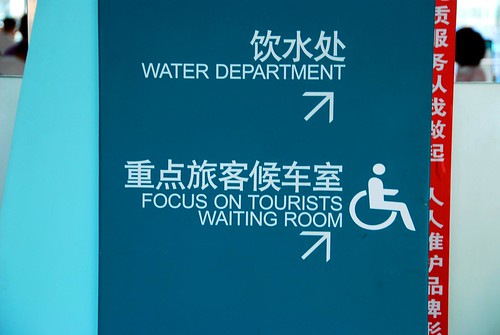
Is this where Chinese people go to stare at the tourists?
At around 2:30PM, I start gathering my things. But hold on a minute…something seems fishy. Why isn’t there a bus at our gate? I examine the ticket (which is all in Chinese), I see the numbers “12:30,” and I start to panic. Did our bus leave at 12:30? Why did the woman at the window tell me 3PM?!? It is possible I misunderstood, but the words for “3:00″ and “12:30″ sound REALLY different in Chinese. So i run up to the information desk, frantic.
Hope: Can you tell me if this ticket is for the 12:30 bus to Taishan? The woman at the window told me it was a 3PM bus!
Information Lady: We don’t have a bus at 3PM to Taishan. This bus left two hours ago.
H: But…but…the woman told me 3PM!
IL: Didn’t you hear them announce that your bus was leaving?
H: I wasn’t listening! I’m not from here!
IL: Well, there are no more buses, you have to leave in the morning.
H: [Almost in tears at this point, and not being coherent] I’m not from here!
IL: [Clearly disturbed by the weird Chinese American girl freaking out] It’s OK, I understand. Here, I can refund your ticket.*
*In retrospect, it was almost unbelievable that she so readily gave us a refund. But I was too distraught to recognize this at the time.
I can’t tell you why I wigged out so badly…the back-and-forth from the bus station to the train station and back again definitely kicked it off, but I think the bulk of it had to do with my growing suspicion that being a Chinese American traveling in China was not an asset, but in some ways a burden. Sure, there are times when it has been awfully convenient to be able to communicate. But there are other times I feel it is easier to have Jeremy’s face in China than my own. I couldn’t shake the feeling that this misunderstanding NEVER would have happened if Jeremy and I were two Western-looking people…they would have tried to find someone who spoke English, or they would have pointed out the time on the ticket.
And maybe that’s why I melted down—because the country to which I have attached my ethnic identity wants almost nothing to do with me. Nobody is trying to take their picture with me (whereas Jeremy’s face must be imprinted on hundreds of memory cards and hard drives around the country). Nobody wants to help me—in fact, sometimes they laugh in my face when I make a “weird” request (like, “can you put some vegetables in my soup?”—what a FREAK!) Or if I don’t understand the phrase they used, they talk about me like I’m not in the room, as if all of a sudden can’t understand anything they are saying. Heck, we even got scammed by my “people.” Do you think a Chinese person would laugh in Jeremy’s face if he mispronounced a word in Mandarin? Doubt it. They’d probably be too busy falling over themselves with adoration.
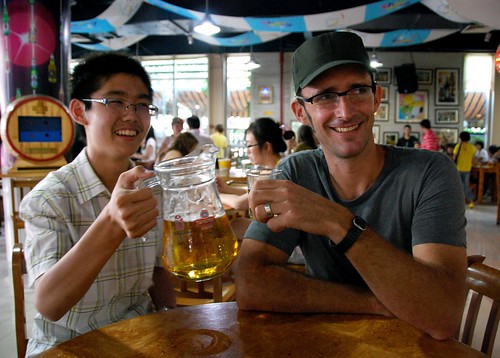
Jeremy posing with yet another unidentified Chinese boy at the Tsingtao brewery.
As a Chinese girl growing up in the USA, I spoke Mandarin at home, went to Chinese school on the weekends, and ate hot pot on Thanksgiving. I thought I was Chinese. Only now, after traveling through the countries of my ancestors, do I find that the truth is much more complicated than that. I find myself grossed out by all the spitting, annoyed with the crowds, irritated by the constant noise, disgusted by the bathrooms…and yet simultaneously, I want to defend this country to the Westerners who complain about the exact same things. I want to explain that Chinese people spit on the floor because they think blowing your nose in a tissue is disgusting. I want to challenge them to live in a country with 1.3 billion people and see what their public bathrooms look like. I want to tell them: just because it’s different doesn’t mean it’s bad.
Oh, the confidence that is inspired by that singular viewpoint!: To always look from west to east and not back in the other direction. Don’t get me wrong—there are many, many gifts that I was bestowed because of my ethnic heritage: a multilingual tongue, respect for my elders, a hair-free body. But that confidence is not one of them.
That day in Qingdao was the only time on the trip I just wanted to click the heels on my ruby slippers and go back home. You know, somewhere I felt like I belonged. Now if I only I knew where that could be…
During the second half of our China trip, Jeremy and I planned on visiting Tibet. The landscape, the people, coupled with our increasing interest in Buddhism, meant that this “autonomous region” in Western China held a strong allure for us. But there are realities to travel in Tibet (besides the obvious political ones), and after doing a bunch of research while we were in Beijing, we decided against the trip. Here’s why.
THE REALITIES
- It’s a long train ride…
…48 hours from Beijing to Lhasa, to be exact. And from all accounts we’ve read, it’s like 48 hours on the Yangzi River Boat (read about our experience here: Three Gorges Yangzi River Cruise: Chinese Immersion School), only sans private bathroom (and if you’ve ever been in a public Chinese toilet, you know that this is no small matter), the aisles are filled with boxes of food and instant noodles (the Chinese love nothing more than to make sure they have enough to eat at all times), and you’re stuck on the train. That being said, it is supposedly a breathtakingly beautiful ride, and if all the other parts of visiting Tibet added up, we totally would have done the trip. But the realities of getting to Tibet are something you really must consider. Sure, you could fly too, but its expensive to do so and you would miss out on seeing the grandeur of the landscape on the way to Tibet. The train track to Tibet is the highest in the world, and each car reportedly contains oxygen masks in case you need help adjusting to the altitude. - The permit application process
Permits have long been required in order to travel to Tibet, and it takes 7 working days to process them, though some places can arrange them for you in as little as 3, while others require a full 10 days. For travelers like Jeremy and I, who barely know where we’ll be tomorrow, much less next week, this restriction did limit our options. Currently, the only way to get a a Tibet travel permit is to sign up for a tour, which brings us to our next point: - In order to travel in Tibet, you must be on a guided tour with the same itinerary as everyone else
Due to the protests in Tibet last year, the Chinese government is being more strict about requiring visitors to be on a tour in Tibet. It used to be that a tour group could consist of 1 person, and we also hear that you used to be able to travel to Lhasa on a tour and then explore the rest of the region independently, but that does not appear to be the case any longer (or if it is an option, it is a very expensive option). We talked to many tour companies, and most itineraries looked identical (with the exception of one Tibetan-based tour company). To make matters worse… - Tibet is a Chinese Disneyland in the summer
The period we wanted to visit Tibet (late July), is tourist high season in Tibet. Every DAY, 12,000 Chinese tourists flood into Lhasa. We just didn’t want our experience of Tibet to be entangled with the pushing crowds and the megaphone-wielding tour guides like so much of China seems to be flooded with these days. In 2009, the Chinese government gave out a large number of travel vouchers to use for domestic tourism in order to stimulate their home economy. Quite frankly, it would kind of break our hearts to see the spiritual center of Buddism turned into a Chinese playground. - It’s not cheap
For the privilege of visiting Tibet, you must be willing to pay at minimum about US$150 per person per day, not including meals. Given that our budget for China was about US$120 per day for the both of us, this really broke the bank. Also, be aware that the cheaper tours are typically offered by government-sponsored travel agencies in Beijing with Chinese (not Tibetan) guides leading the tours, and very little of your US$150 per day will go into the pockets of Tibetans. The government-sponsored agencies are often able to offer lower prices because they have an advantage in procuring train tickets (they are allowed to purchase tickets in big blocks before they are available to the rest of the public…and then sell them to smaller tour operators at marked-up rates).
WHAT YOU CAN DO
We don’t necessarily advocate avoiding a region or country altogether when you don’t agree with the political climate. But we do think it’s wise to do your research and make sure the bulk of your tourist dollars are going to the right places.
- Plan ahead and do your research
Quite frankly, this is where we got stuck…if we would have started researching the Tibet trip earlier, we probably could have made it happen. But waiting until we were in the country to do our planning (which is our normal M.O.) just doesn’t work for Tibet. Read as much as you can on the travel situation, as it can change dramatically from month to month. Here’s an excellent website we found: Life on the Tibetan Plateau. And of course, check out Lonely Planet’s Thorntree Forum. Also, as with any tourism you do, be sure to read up on the local culture so you can be a culturally sensitive traveler! - Make sure you choose a Tibetan operator and get a Tibetan guide
You can make arrangements for your Tibet tour in Beijing, Xian, Chengdu…basically any big city in China. But many of these travel agencies are Chinese-owned, which means very little of your tourist dollars will actually go to the Tibetan people. Make sure your money is benefitting the people who are most affected by your visit and find an agency than actually operates from Tibet. Also, we found that many of the Tibetan-operated agencies had different itineraries, so you won’t be hitting all those gorgeous sights when all 11,999 other tourists in the region are flooding in.
We sincerely hope that the Tibetan travel situation eases up in the future. We would love to one day explore this magical land without the restrictions that have been a reality of the recent past.
Since I already wrote a book about your typical homestyle Northern Chinese fare when we were in Taiwan, I’m not so much going to explore the What (as in What is good) of Beijing cuisine, but rather, the Where (as in Where we ate). The food in Beijing is the best we had in China (though to be honest, the best Chinese food is still over in Taiwan).
First things first: China is a huge country, and there are many regional differences in speech, appearance, and yes, diet. But there is one major difference between the north and the south when it comes to cuisine: the north is all about noodles, and the south is all about rice. This is a common explanation for why people in the north tend to be taller than those in the south (take a wild guess where my freakishly tall family is from). I’m not exactly sure why a noodle-based diet would result in a taller population, but if I had to take a guess, I suppose it’s the egg protein in the noodles. Anyway, because meat was more scarce in the past, and because people in the south eat rice as their carb, southern cuisine tends to be very oily. Hey, people need to get their calories somewhere.
This could be the reason why J and I preferred food in the north. Our Northern California palettes prefer light and fresh over heavy and rich. This is not to say we don’t like rich foods—after all, I wouldn’t exactly describe ramen as “light and fresh.” Rather, we just like our food to taste like itself (we want spinach to taste like spinach and not like oil).
That being said, we ate a whole lot of stuff that tasted like Peking duck while we were in Beijing. ![]()
Our first taste of Peking duck was our meal out with my aunt and uncle at our hotel’s (King Parkview Hotel) adjoining restaurant, which, surprisingly, turned out to be quite good! I’ve had Peking duck in the States before, but it is totally different experience in Beijing. The process begins by choosing a duck, and then a person that I can only describe as a duck surgeon comes out and carves your bird into paper-thin slices.
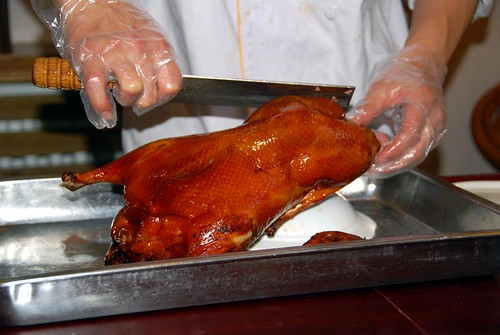
The duck surgeon hard at work in the King Parkview Hotel Restaurant.

My aunt (daughter of my Nai Nai’s older sister) and uncle in front of the Bird’s Nest. Aren’t they cute?
The paper-thin slices of Peking duck are then usually sandwiched between a small piece of bread with some hoisin sauce and additional goodies. In the States, these “additional goodies” consist of spring onion (bo-ring!). But Beijing puts the “good” in “goodies,” as at Hua Jia Yi Yuan on “Ghost Street” or Gui Jie (one of the most famous eating streets in Beijing), where you get all kinds of fun treats, like cucumber, pickles, even pineapple!
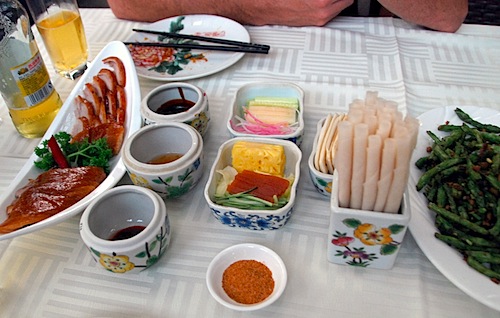
Hua Jia Yi Yuan’s Peking duck toppings.
Gui Jie has a lot of courtyard restaurants, and the atmosphere is fantastic.

The interior of Hua Jia Yi Yuan.
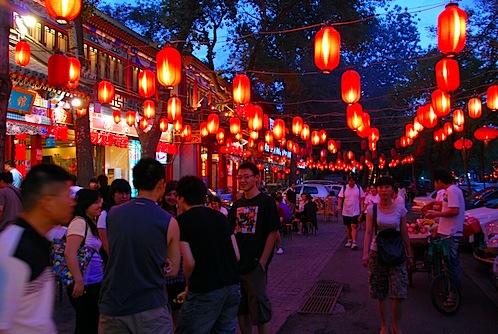
Red lanterns add to the atmosphere on Gui Jie.
We also ate at one of the most popular Peking duck restaurants in all of Beijing: Dadong Duck Restaurant. Our verdict? Unremarkable and overpriced, though you do get free drinks while you are waiting for your table. That’s all we have to say about that.
We enjoyed many a meal by Qian Hai Lake (also sometimes called Hou Hai–the two lakes are adjoined so you can refer to it by either name). Very touristy, but if you look hard enough, you can find budget restaurants. The evening light on the lake is really beautiful, and you can watch locals go for a dip in the water.
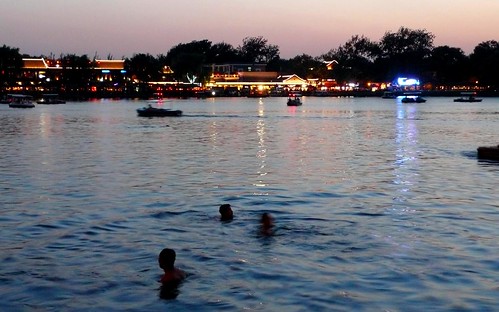
Locals taking a dip in Qian Hai at sundown.
Not all of our meals out consisted of Peking duck. We also had some good, old fashioned jiao zi (dumplings). The best place we ate (by far) was a small shop called Xia’r Lao Man (translation: “Filling Always Full” or “Stuffing Always Stuffed”), where we had jiao zi with pork and fennel stuffing (yum), and an incredible liang ban (cold salad) of cabbage, bean sprouts, cilantro, sesame oil, garlic, and peanuts.
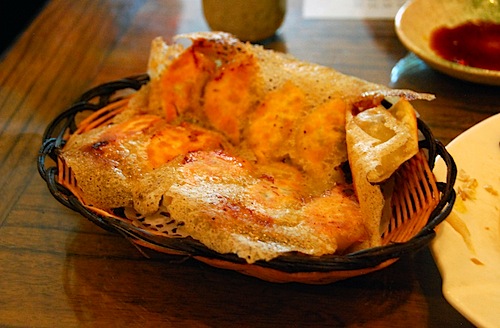
Pork and fennel guo tie (potstickers). They come out of the kitchen like this, the dumplings connected by a solid sheet of fried. Mmm…fried…
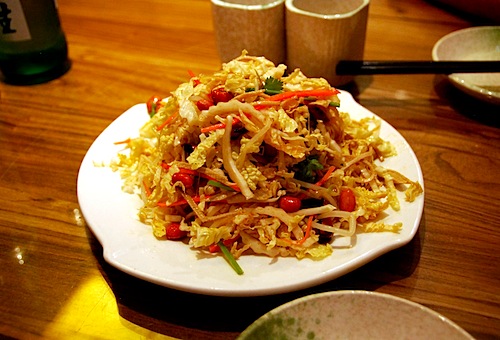
Lao man’r liang ban salad. So refreshing on a hot summer day!
Beijing food just can’t compare to the weirdness of some of the food we ate in the south, or the scariness of the food in Chongqing, but they sure try hard to compete on Wangfujing snack street, where you can get LIVE scorpions on a stick (seriously, they wiggle around on there), topped off with a seahorse.
Of course, if you’re longing to live on the wild side without risking a scorpion sting, you can always order “The palace explodes the diced chicken.”
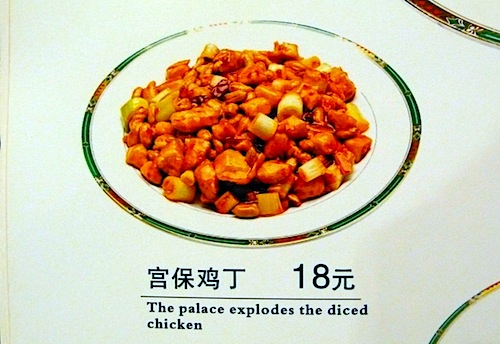
Or impress your friends by telling them you ate the little-known “Agrocgble aergerita.” With fish heads, of course.
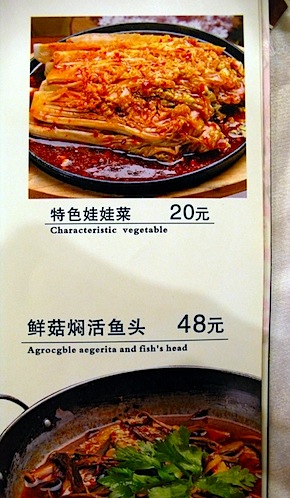
One thing you have to give the Chinese credit for: they don’t hide anything. Part of it is that so much of their lives are lived outdoors. Just walk around the city, and you’ll see so many little intimate moments that are a part of everyday life around here.

How many more minutes until the end of my shift?
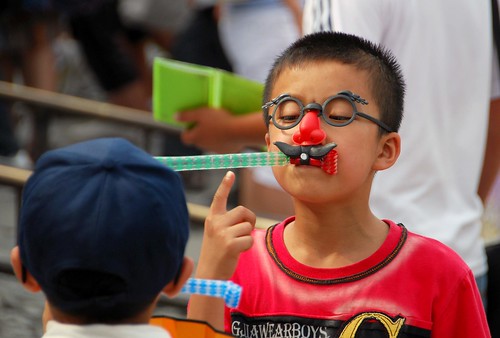
Two brothers square off in Groucho glasses.
One thing that really impressed us here at 12FOOT3: Chinese people really know how to use public spaces. Everywhere you look in Beijing, there are people hanging out, talking, sitting in the shade, playing with the grandkids. I mentioned in our last post that we were charmed by a Sunday spent in the Temple of Heaven Park watching hundreds of people mingling about, doing their Sunday thing (which included ballroom dancing, playing games, singing, hacky sack, calligraphy, and more).
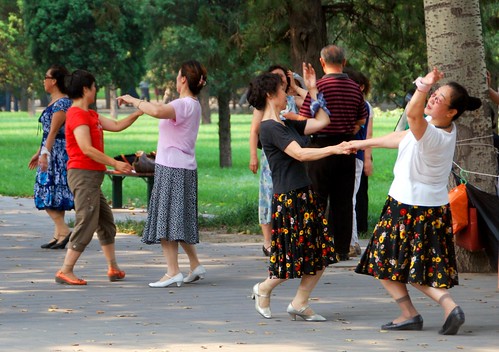
Women ballroom dancing in the park. How cute is it that the two on the right are wearing matching skirts?
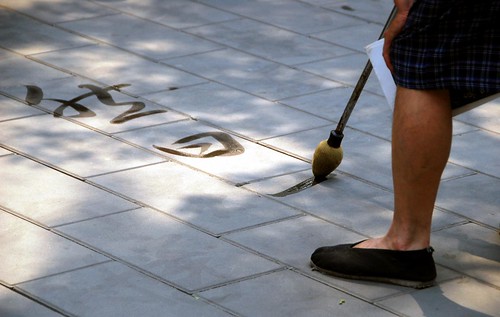
Practicing calligraphy in the park.
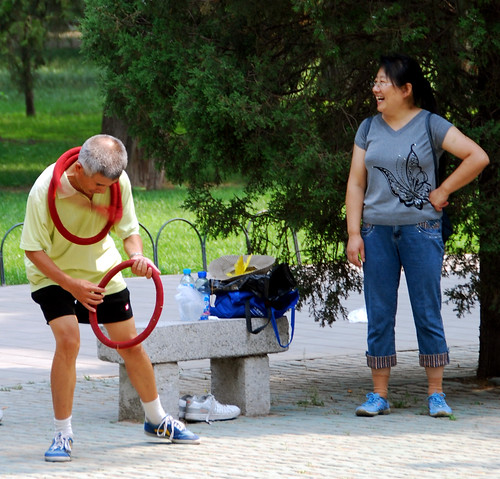
Playing “catch-the-ring.” You play the game in pairs—your partner throws three soft rings from about 100 yards away, and your objective is to catch them around your neck.

As far as we could tell, it seemed like this woman just showed up in the park with a full band, and people wandering through the park spontaneously gathered around them to sing traditional Chinese songs (I even recognized a few from my Dad’s karaoke hits!).
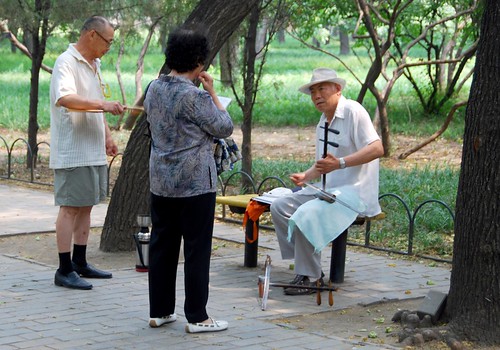
A more intimate version of the big brass band pictured above: just one musician and his dedicated singer.
The other reason why it’s all on display in Beijing is that Chinese people just have different notions of privacy than we do in the west.
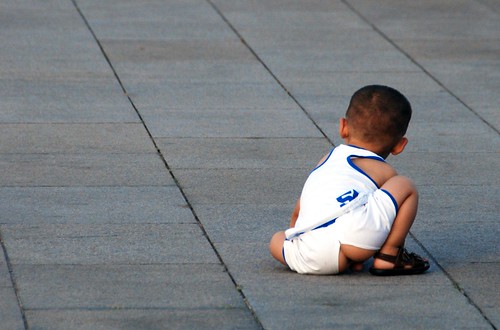
Yes, kids are still wearing the split pants around Beijing. Though I saw a LOT fewer kids wearing these in Beijing than I did in 2000.
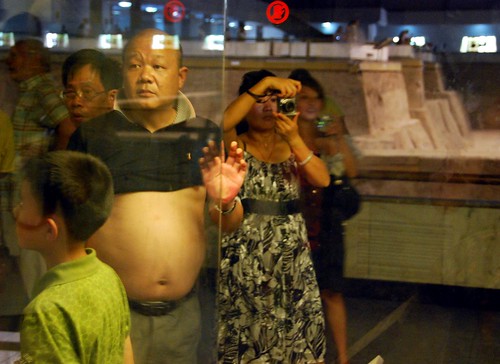
OK, this particular photo was actually taken in Xian, but you see these big Buddha belly guys walking around EVERYWHERE. And I mean everywhere—museums, hotel lobbies, fancy restaurants…
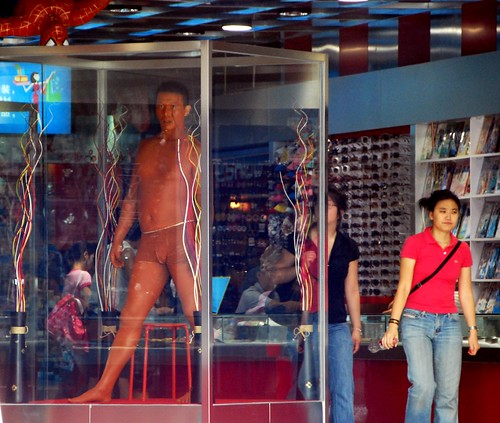
Um, we don’t really know what’s going on here either.
Things HAVE changed around here since the Olympics. For one, people don’t stare…as much (don’t worry, they still stare). I guess they got their fill of wai guo ren’s in 2008. And it does seem that things are a little less raw around the capital city than they were in 2000. There are public bathrooms every two blocks, and they are clean! But the important thing is: the Beijing flavor is still there, and it seems that the Olympics just served to elevate this beautiful city to a more international/cosmopolitan level.
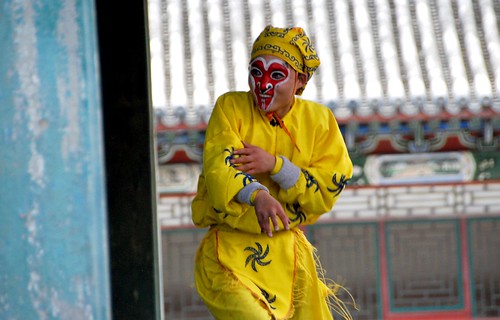
Chinese acrobat at the Summer Palace.
Note: There is a LOT to see and do in Beijing. I mean, it’s almost ridiculous. Not only are there incredible modern and historical buildings to tour, but the culture in China’s capital city is rich and full of life. So for this special city, we’ll be taking a different approach. In a 3-part series, we’ll be sharing the sights, the people, and the food of Beijing with you. We’ll go heavy on the photos and light(er) on the commentary.
If China had a motto, it would be “Go big or go home!” So it makes sense that the sights around China’s capital city are massive. Parks, palaces, walls…you name it, they are share one thing in common: they’re Big (that’s capital “B” Big).
The Forbidden City did not fail to impress, even the second time around (for me, it was the first time for Jeremy). Unfortunately, we showed up at about 10:30AM, which is when most of the tour groups arrive, so our visit was characterized by pushing crowds and tour guides with microphones turned up to “11″ (no fun for my noise- and crowd-averse husband). Here’s a tip: if you ever visit the Forbidden City, go around noon when the tour buses take the masses off to lunch. When we were through checking out the palace grounds, we happened to walk back through the compound (instead of exiting the north side) and NO ONE was around.
Beijing is another city (along with Chongqing and Shanghai) where we have family, and after dinner of Peking duck with my aunt and uncle one night (more on this in the next post), they drove us out Olympic Park. It was really exhilarating to see these gorgeous buildings in real life, especially since Jeremy and I got chills watching the Opening Ceremonies last year on TV. We got really lucky and happened to go on an event night, when the lights were on (apparently the Bird’s Nest and Water Cube are not usually this colorful).
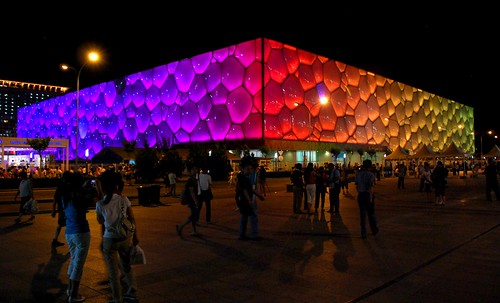
The Water Cube during a rainbow moment. The building’s “skin” is constantly changing color.
When my uncle heard that we planned to visit Simatai (a remote part of the Great Wall) the following day, he arranged for his driver to take us, which was really fortunate for Jeremy and I because it would have taken a LONG time to get there on public transport. Last time I went to the Great Wall, I only saw Badaling, a very touristed part of the wall. Simatai was virtually empty, and we had glorious weather out there: blue sky, fluffy clouds, and a light breeze to cut the summer humidity. Seriously folks, it looked like New Zealand out there!
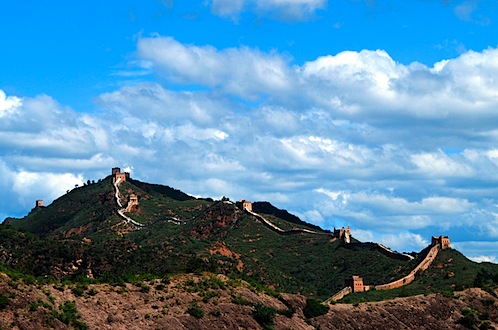
Yes, we had amazing blue skies while we were in Beijing, but Oh. My. God. Was it Hot. So Hot I’m using a capital “H” to describe how Hot it was. The day we visited the Summer Palace (the place where the Empress hung out when it got too scorching in the city), we couldn’t make it more than 10 minutes before taking a break to suck down some water or eat an “Old Beijing popsicle.” They don’t sound that appetizing, but they are cold, sweet, and only cost 1 RMB. We must have eaten at least 6 of those while we were at the Summer Palace.
As for the Palace itself? Impressively large, but a bit over-restored for my tastes. Call me nostalgic, but I like my old things to look old.
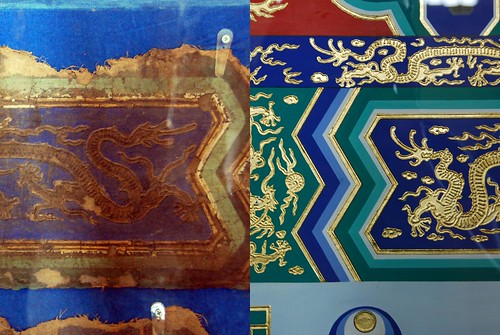
Before and after restoration photos of the paintings around the Summer Palace.
The sprawling Temple of Heaven Park (Tian Tan) was a love/hate thing for us. We adored all the locals hanging out in the park dancing, singing, playing games, and practicing calligraphy, but once we got to the actual tourist destinations (like the Temple of Heaven itself), the tourist crush started up again. Unless you’re really into Chinese architecture, just hang out in the park and soak up the ambience, and skip the actual temples.
Beijing has some wonderful outdoor public spaces. Our hotel was located right next to Jing Shan Park, so we walked through a couple of times to enjoy the fading light over the capital city.
When we weren’t touring “sights” or hiding under the air conditioning of our hotel room, J and I just wandered: in and out of Beijing hutongs, around the shops and restaurants of Houhai or Qianhai lakes, and up and down main thoroughfares, taking in this city of perpetual movement.
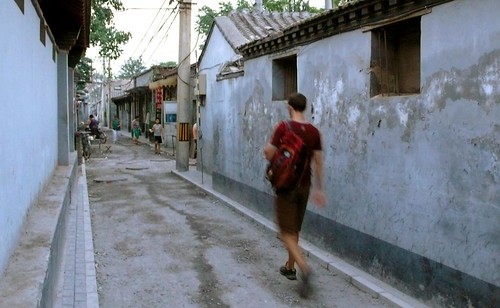
Walking to dinner in the fading light of a Beijing hutong.
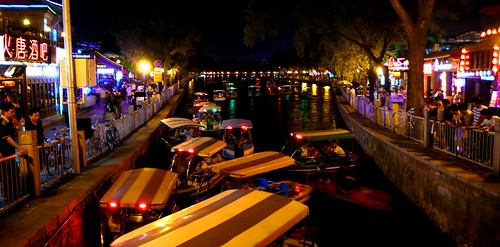
Evening boat jam in Houhai Lake.
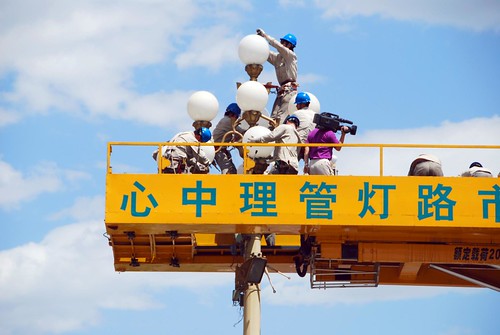
How many Chinese people does it take to change a light bulb?
To be clear: It’s not that Jeremy and I were hesitant about returning to China, but I wouldn’t say that we were excited about it either. It’s always a bit of a downer leaving a country you really enjoy, and after our rude transition from magical New Zealand to Australia, we knew we had to prepare ourselves mentally for our return to the People’s Republic. So we visualized putting our smog goggles back on, honed our elbow reflexes so we could successfully fend off any would-be line cutters, and dusted off the ear plugs.
And then, we saw this from the plane:
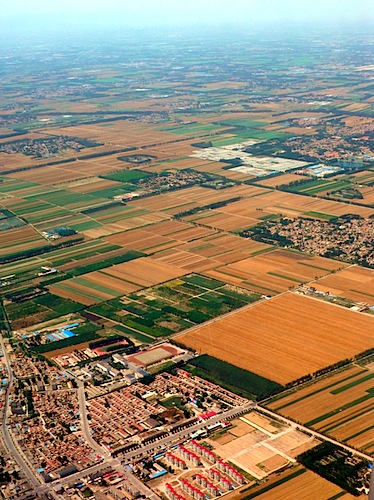
View of the Chinese countryside outside of Beijing.
I told Jeremy, “the airport is really far outside the city, so I bet we’re still outside the smog bank.” Memories from my visit to Beijing in 2000 are clouded by a thick grey cast over the city and the matching tissues when I blew my nose, so I was understandably a bit skeptical.
As we landed, we were told that the Quarantine Authorities would be coming through to check everyone’s temperatures before we deboarded. I tucked in for a long wait at the gate, but true to Chinese efficiency, three QA’s in haz-mat suits got on, shot everyone in the face with a temperature gun, and cleared us to deboard faster than you can say “H-yi-N-yi” (that’s H1N1 in Mandarin).

A quarantion authomite taking face temps on the plane.
We wandered through Beijing’s gorgeous new terminal 3 towards immigration, where the friendly officer spoke to me in perfect English (that was weird…speaking to a Chinese person in English) and marveled at the collection of stamps in my passport.
After quickly clearing immigration, we boarded the comfortable train into town. Less than an hour later, we were headed towards our hotel under gloriously clear skies.
OK, OK. HOLD UP! What is this?!? Nice people, efficient bureaucracy, uncrowded public transport, AND a smogless sky? Did we get off the plane in the wrong country? Is someone playing a really, really mean trick on us?
Well, guess what…all those driving restrictions and factory shut-downs that Beijing put into place for the 2008 Olympics have finally paid off. The sky was crystal clear for our entire 5-day stay in the capital city. I can’t tell you what a difference a blue sky in Beijing makes…our hearts soared, our eyes delighted, and we felt more in tune with this city than any other in China.
We ended that first day with a long walk to watch the sunset in Tiananmen Square. There were police guards all around and you couldn’t loiter at all at the entrance to the Forbidden City. But hey, we’ll trade some subtle military intimidation for a blue sky any day.
If you like your culture with a dash of comfort, or your peace with a little quiet, then Japan is the name of your travel game. Japan felt like an oasis in the middle of crazy, chaotic Asia, and we found a lot of similarities between the culture here and the one we fell in love with in Taiwan.
Over here at 12FOOT3, Jeremy is the nature lover and I’m the culture vulture, and Japan has got enough to keep us both happy. From fashion, art, style, and design in Tokyo to forests, flowers, and bamboo in Koyasan, (or the intersection of nature and culture in Naoshima), Japan has got it all. Go, and let us know what you think. We’re pretty sure you’ll love it too.
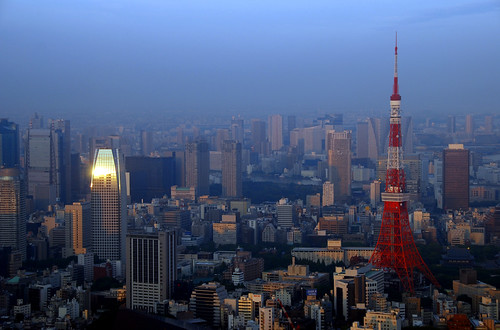
View of Tokyo Tower from the Mori building.
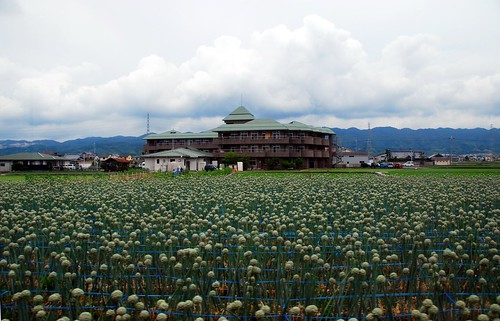
The Japanese countryside, somewhere between Osaka and Naoshima.
Days spent here: 19
Highlights: There wasn’t a place we didn’t like: Tokyo, Kyoto, Koyasan, Naoshima, Takayama—each big city or little town was fabulous in its* own way. Shirahama was a bit resort-y for our tastes, but since we were there before the start of the “official” beach season, it was empty and quiet. That, and the fabulous onsen on the beach, made it worth the trip.
* Hi Adam!
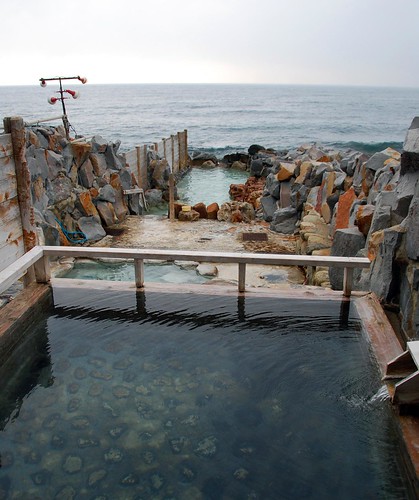
Sakino-yu onsen in Shirahama. The Pacific Ocean crashes over the wall into the cold pool.
Places we would like to visit next time: For us, it’s less about where we’ll go next time and more about when we’ll go. We’ll gladly return to Japan in spring (cherry blossom season), autumn (fall colors painting the Japanese maples), or winter (snow sitting on temple rooftops).
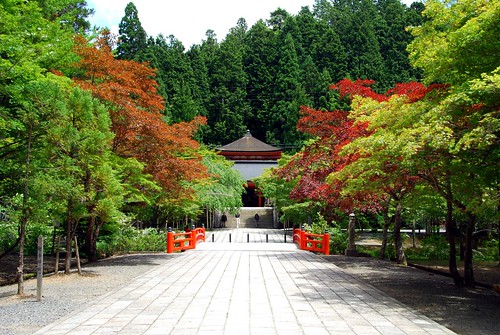
A taste of what autumn in Japan might look like. Taken in Okunoin cemetery, Koyasan.
Average daily expenditures: US$240 (Ouch! Though a good US$50 a day was due to our JR Rail passes.)
Prices: Yup, Japan is expensive. Food is expensive, accommodation is expensive (see the accommodation section below to find out why), and public transport is…guess what? Expensive. In return for parting with your hard-earned cash, you get fabulous food, a high level of comfort and cleanliness in the guest houses, and some of the fastest, easiest, and most convenient transport experiences you can find in this world. In other words, you get what you pay for in Japan. But be prepared to pay a lot.
Weather: We were traveling in Japan during the supposed “rainy season” (June), though it only rained hard twice (and then boy did it rain!). Most days were overcast, humid, but not too hot (maybe mid-70s to 80s?).
Language: Hey you out there! Yeah, you…the one who thinks all Asians look alike and wouldn’t be able to tell a Beijing babe from a Tokyo Tomo. Well, guess what? You’re off the hook for cultural insensitivity, because apparently Asians think all Asians look alike too. EVERYONE in Japan thought I was Japanese and would rattle on to me for several minutes before they caught on to my blank stare. I would have the following conversation with at least one Japanese person every day:
Japanese Person: Irashaimase! Tekka tekka tekka tekka tekka HAI! Tekka HAI! Tekka tekka tekka HAI!
Hope: Uh, watashi wa…
JP: [waiting patiently]
H: …nihongo ga…
JP: [still waiting patiently]
H: …wakari masen*. (Translation: “Um…I don’t understand Japanese”)
JP: Oooaawwaahh**! HAI!
* I had to learn this phrase immediately upon leaving Tokyo.
** Japanese people make the most amazing sound effects.
Food: Yo, it’s good.
One thing I forgot to mention in my food post—some of you are probably wondering what the deal is with the $40 melon or the $60 grapes you hear so much about. It’s not like Japanese people have to take out a second mortgage in order to eat fruit. Rather, these are gift items—a $40 melon is a token that shows your appreciation for the receiver of said fruit. See, everyone knows that THAT is the $40 melon, and the receiver will know it too.
Accommodation: A big chunk of your travel budget in Japan will go towards accommodation. Why? Well, in Japan, rather than paying for a room, you pay by the person. So if you are a single person traveling, you might get a room to yourself for ¥4000 (about US$40). But a couple staying in a similar room will have to pay ¥8000. That’s just the way they do things in Japan. Them’s the breaks.
Budget places tend to run between ¥3000 to ¥4000 (US$30-40) per person per night. So even a budget hotel will cost a couple US$80 per night. For that reason, Tokyo and Kyoto are a good place to try to use miles on hotels if your mileage program will let you do so, because housing is extra expensive in the big cities. You can also try JAPANiCAN, which often has great deals on accommodation.
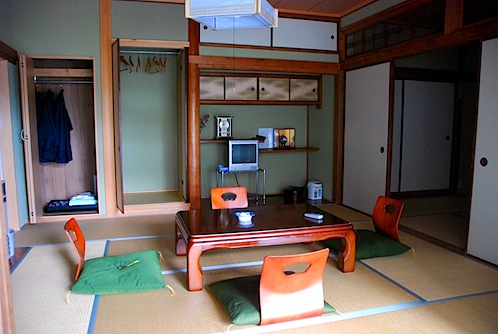
A typical Japanese-style room (though this one is quite spacious).
If you’re traveling on a budget, you’ll want to look for shukubo (temple lodgings), kokumin shukusha (”people’s lodges”), and minshuku (the Japanese version of bed and breakfast, downmarket from the fabulous ryokan). Sometimes a minshuku will offer you a choice of Western or Japanese-style room. We always opted for the Japanese-style accommodation, which means your room will have tatami mats, a small coffee table surrounded by cushions or chairs (like the one pictured above), your bed will be a futon mattress stored in the closet and brought out at night, and your pillow will be stuffed with buckwheat.
Again, despite the high costs, you will get quality from Japanese hotels and guest houses—your room will come with a cute kimono-style robe, a tea set and hot water heater, and (if you stay in the Super Hotel in Kyoto) your choice of pillows (buckwheat, memory foam, or feather, of different densities and thicknesses). Plus a little Japanese atmosphere to boot if you choose the local style accommodation.
Transit: Japan’s national rail system is really, really amazing. You can get to every corner of the country…and often at no additional cost if you spring for the JR Rail Pass. Granted, the pass is not cheap, but you definitely get what you pay for. The trains are super fast, efficient, ultra clean, and comfortable.

On the train from Takayama to Tokyo.
I know that Tokyo’s Metro is supposedly a transit lover’s dream come true, but we found it hard to navigate at times (seriously, the maps look like a pile of multi-colored noodles!).
Internet: As we’ve come to find on our travels so far, Japan adheres to the unwritten international commandment of “developed countries shall be stingy with their wifi.” If our guest house did not have wifi, we could sometimes find an unlocked connection on the street. Of course, my iPod Touch chose to break down in this country, which made it even harder to keep up with friends and family back home. I ended up buying a new iTouch in Tokyo (interestingly, one of the cheapest places in the world to get one…but only by a little bit).
Culture: What you’ve heard about Japan is true—people are exceedingly polite. But Japan is also a rules-based society, and as our hosts Joy and Alex explained, you can ask a person for directions and they are so polite that they walk you to your destination—but ask them to do anything (ANYTHING!) that is against the rules or the process, and you’re in for a long struggle. Put the mustard on the side? Substitute lettuce for tomato? I don’t think so, Mr. Big Shot Rule-Breaker Man! The problem is, again, Japanese people are so polite that they won’t just come right out and say “no.” Instead, they’ll talk around it…you’ll get answers like: “that might be difficult” or “um, I will need to ask if that is possible.” This cultural trait generally does not affect visitors much, but I imagine if you are a Westerner working in Japan (as Joy and Alex are), this can be really frustrating.

Schoolkids in Koyasan. Don’t they already look like good citizens? ![]()
The other insight our ex-pat friends shared with us: you don’t want to be around when a repressed Japanese person finally goes postal. Japan is exceedingly safe, but Joy admitted that the one time she ever feels scared in Japan is when someone is losing it. We saw a guy in Tokyo try to run another guy over at least 3 times (they were having some sort of argument).
The following video is really only tangentially related to the above topic, but it’s pretty funny so I thought I’d share:
The point of this “game” is to pop the other kids’ balloons mounted on their side of their helmet. WITH A STICK. About 12 seconds into the video, you can see one kid fall down and then all all the other kids start wailing on him/her.
The other well-documented aspect of Japanese culture is their obsession with the absurd. You’ve probably seen many examples of this, from Japanese game shows to useless inventions, etc. But the cutest example of Japanese weirdness has to be the raccoon dog. These little statues are everywhere, and they are called tanuki, a mythical creature that is jolly and mischievous. Our campsite in Naoshima even had a sign telling the raccoon dogs not to eat shoes or steal food (wish I took a picture of that)
Tanuki are characterized by their big pot bellies and get this—their humorously large testicles. I am not joking—there is even a schoolyard song about them:
Tan Tan Tanuki no kintama wa,
Kaze mo nai no ni,
Bura bura
Roughly translated, this means “Tan-tan-tanuki’s testicles, there isn’t even any wind but still go swing-swing-swing.”
I got all this from the Wiki entry so it MUST be true.
In short: It’s really, really lovely in Japan.
Oh Shanghai…sweet, sweet Shanghai. Actually, as a city, we weren’t that fond of Shanghai (more on that later), but we were nonetheless relieved to be back. You see, Shanghai was the final stop on the first leg of our China tour. We had been in the country for almost a month, though it felt like much longer since we saw so darn much. We will return to China via to Beijing in the near future, to explore the northern and possibly western side of the country for another 3 weeks. But in the meantime, we’ve got a two-week stint in Japan. And quite frankly, we’re ready for the break.
While it has been incredibly interesting from a cultural perspective, traveling around China isn’t exactly what one might call a relaxing experience. Just the day-to-day here requires a huge amount of concentration. Making sure you don’t get spit on. Keeping an eye on that lady who is clearly jockeying to cut in front of you and goddamn it, you are not going to let her slide in front because you clearly got there first! Trying to keep calm in the taxi when you’re sure the driver is trying to kill you. Trying not to lose your cool when that woman trying to sell you a hotel room just won’t stop following you. The constant cigarette smoke. The constant noise. Making sure you don’t get robbed or ripped off. And doing it all in a language that is not native to you.
In some ways, I almost think that being able to speak Mandarin doesn’t make it any easier for us than it is for someone who doesn’t speak a lick of the language (though the challenges are different). At least people will try to speak the little bit of English they know if you look Western. But the thick regional accents, combined with my limited vocabulary, make every conversation a somewhat stressful experience. And of course, the fact that I am the only one who can communicate is not easy on either of us.
On top of all this, I never realized just how much my mood is affected by seeing a blue sky until I didn’t see one for weeks. Out of the past 28 days, we could count on one hand the number of days we saw the sun or a blue sky. The quality of the air here is, without a doubt, dreadful. It’s clear that the planet cannot continue to support whatever it is that China is doing to it. This is not a joke: if China doesn’t shape up it’s environmental act, this planet is doomed.
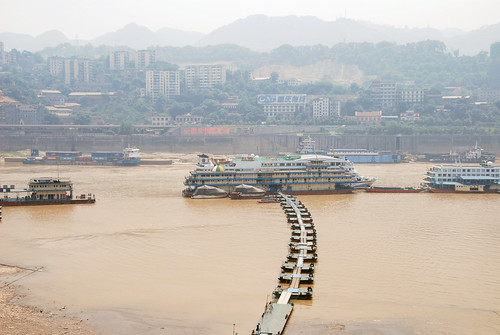
Yet another grey day in China. Taken in Chongqing, looking across the Jialing River from Jiefangbei.
So yeah, we were happy to be back in Shanghai, not only because it meant we might soon see something other than smog in the air, but also because we have family friends in the city, and there ain’t nothing more comforting than a familiar face when you need a little perspective. We stayed with my grandparents’ (Yeh Yeh and Nai Nai’s) goddaughter Vivian Gugu, and once again, we got put up in a sweet apartment in a great location.
We also got to see my Uncle Jack and Aunt Grace, very close family friends of ours. My brother and I grew up playing with Philip and Michael (their sons), and our moms were best friends in Chula Vista. Now Uncle Jack and Aunt Grace are living in Shanghai, and they treated us to a lovely dinner. They haven’t changed a bit, and it made me feel right at home to see their smiling faces.
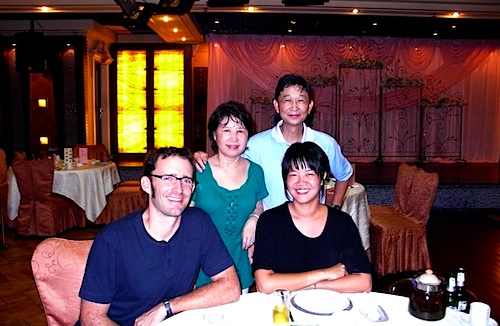
Since we had seen all the major tourist destinations around Shanghai the first time we were in the city, J and I took it easy, taking care of some business (we bought our Japan Rail Passes, which must be purchased before arriving in the country), but otherwise spending most of our time hanging out in cafes or checking out Shanghai’s art scene.

Shanghai has some great cafes, like this cool one in the French Concession area.
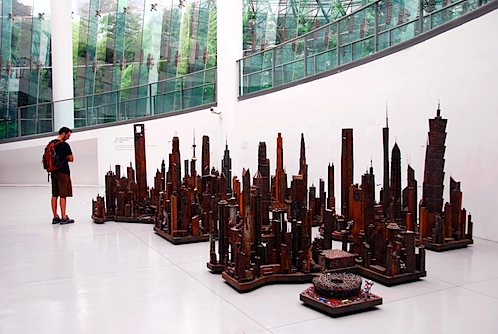
Cool walk-through sculpture consisting of all the major buildings in China, modeled using salvaged mechanical and electrical parts—it’s meant to be a commentary on the environmental impact of China’s rapid development.
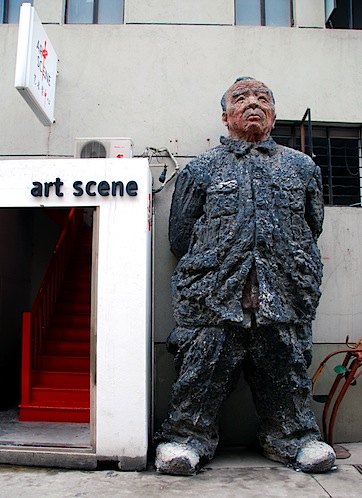
Vignette from Shanghai’s 50 Moganshan Road Art Centre, a cluster of art galleries tucked away in a large, industrial complex. One friend described it as a “Disneyland for artists.”
It was great to see friends and family in Shanghai, but in general, we weren’t too excited about the city itself. It just sort of felt like a big, soulless metropolis to us. At this point we feel pretty adept at picking up on the “vibe” of a place quickly, but Shanghai felt a bit empty to us. It’s hard to explain…it was just neither here nor there, neither rooted in the past nor a model of the future. I don’t know, plenty of people like Shanghai, so maybe it just didn’t gel with our personalities for whatever reason.
And China? Well, my initial reaction still holds true. Of all the countries we’ve been so far, China is the most relevant—it has been fascinating to witness firsthand this country’s shifting economic and politic landscape. And China has definitely the most extreme culturally (at some point on our Yangzi River boat trip, Jeremy turned to me and asked, “Just what exactly IS considered rude in China?!?”).
But we’re a little worn out. And a little discouraged from having to keep our guards up all the time. Leave it to China to make us want just a little vacation from all this traveling. ![]()
